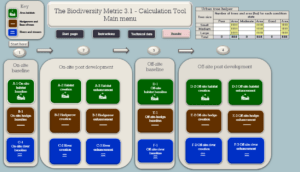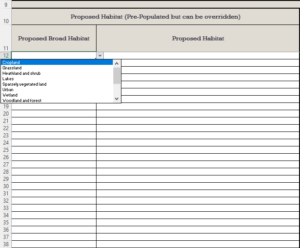The Biodiversity Net Gain Metric, a Developer’s Guide.
Biodiversity Net Gain (BNG) is a metric and an approach to development that aims to leave the natural environment in a better state than it was before, where the state is determined by ecological metrics defined by Natural England, and where the gain is assessed by a Local Planning Authority (LPA). [1] [2]
What is the Biodiversity Net Gain Metric?
As the law on BNG currently stands, the metric is defined by identifying habitat types, e.g. river, hedge, meadow, etc., which then are used to calculate parts of the metric itself. These are indicators of current and projected Biodiversity in certain areas. Below, see an example of the metric BNG version 3.1, which comes as an excel spreadsheet.

The current version at the time of writing, BNG version 3.1 accounts for changes between Pre-development and Post-development, also Post-intervention habitats, e.g. future biodiversity offset estimates. With temporal, spatial, and difficulty multipliers acting on ecological facts, the final outcome of the metric value, the BNG percentage is, at best, an informed expert interpretation of the ecological facts given the development work carried out both on and off-site.

Aside from filling out the BNG spreadsheet to get a final percentage metric, Gantt charts can be used to illustrate the process in detail, to help others involved in project management and planning.
You can download information about the metric here and see the spreadsheet referenced in the above images here. [3]
The Biodiversity Net Gain Guide.
We recommend consulting an expert ecologist, and optionally a landscape architect to advise you during the project’s design process. Consulting an expert is necessary to mitigate costs that can be incurred due to the destruction of ecological features on-site. If such features are destroyed, significant extra cost and effort are required to then increase the BNG. Baseline units and gains are determined by the use of the spreadsheet which gives a result based on the final design and net change in biodiversity units.
Mitigation hierarchy.
The Mitigation hierarchy is an important concept, and protects the environment in order of precedence. The hierarchy should be applied to every development.
- Avoid harm.
- Minimise harm
- Rehabilitate and enhance onsite
- If the development cannot do 1-3 use offsite offsetting.
In terms of costs, 1. avoiding harm, e.g. protecting trees and topsoil in situ, incurs minimal cost.
You get in touch with expert ecologists from Landvision to discuss your project’s needs. To do so, visit our contact us page.
What’s next for Biodiversity Net Gain Metric?
Natural England is set to this policy for the foreseeable future, however, they will continue to finetune the metric over the coming years, in order to increase the certainty that the measures of this policy indeed work, according to the view of experts, as stated on the Natural England blog.
It is vitally important that habitats are managed and maintained for the duration of the BNG agreement (30 years) and that, if necessary, corrective measures are implemented if the BNG outcomes forecast through the metric are not forthcoming. None of us wants to see an outcome that looks good in the metrics calculation but then fails to materialise on the ground. [2]
Additionally, understanding the end impact of a project can take a long time, which is why Natural England aims to extend the monitoring of sites for longer.
Currently many habitat plans only consider what is needed over a 5-10-year period. BNG requires habitats be secured for at least 30 years, which means they must be managed and monitored. [2]
Note, that this includes funding of both site management and monitoring of the natural areas by ecological consultants.
To conclude, and reiterate Natural England, the outcome of biodiversity net gain is not just about the metric, it is also up to the ecologist to liaise with the LPA to determine whether the metric works. As to whether the metric really works in practice, a registry of data will be maintained of sites that deliver BNG, which will help work as a means of iterating and finetuning the policy.
Summary of Biodiversity Net Gain Guide.
In summary, developers need to take into account the natural environment when they are planning a project by hiring an ecologist at an early stage. The Biodiversity Net Gain metric is the tool ecologists will use to account for the environmental impact of the project.
If you need to consult an expert ecologist for your project. Please don’t hesitate to contact us.
References
[1] – https://www.local.gov.uk/pas/topics/environment/biodiversity-net-gain
[2] – https://naturalengland.blog.gov.uk/2021/09/21/biodiversity-net-gain-more-than-just-a-number/
[3] – http://publications.naturalengland.org.uk/publication/6049804846366720
